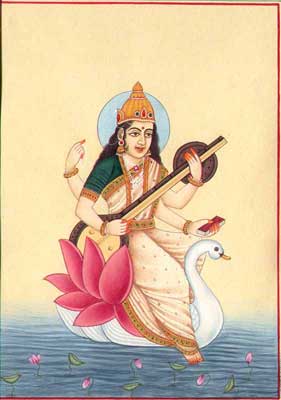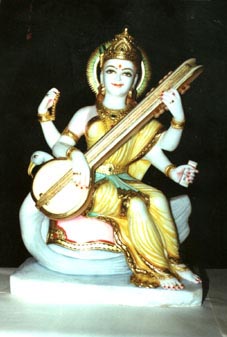The White Moon Gallery Presents
|
|
||
|
|
Saraswati |
|
|
|
||
All Images Courtesy of
http://www.hindupaintings.com/lakshmiandsaraswati.htm
Used with permission. Thank you!
Saraswati
is the Hindu Goddess of wisdom, learning, arts, knowledge, performing arts,
music, and speech. According to Bansi Pandit (1), the Sanskrit word sara
means ‘essence’ and swa means ‘self’. Thus Saraswati means ‘the essence of
self’. She is represented in mythology as the divine consort of the Hindu
Lord Brahma, creator of the universe. Most commonly Saraswati is worshipped by
students, scholars, teachers, scientists, artists, and all who are interested
in knowledge. Saraswati is the sister of Lakshmi and her name is also spelled Sarasvati.
According to most myths, Saraswati did not have children. She is said to have
a temper and is easily provoked and quarrelsome. She has a very independent
will and does not easily oblige to the male gods.
Legend says that Saraswati sprung from the forehead of her father Brahma. Her mother
is the Goddess Durga. Brahma looked upon Saraswati’s beauty and desired to
seek her as his bride. Saraswati disliked his attentions and tried to avoid
him, but wherever she moved, Brahma grew a head in that direction so he could
see her. Although Saraswati did elude him, legend claims that Brahma managed
to marry her. Legend also tells us that Brahma found Saraswati a bit too
aloof, absent minded, and argumentative for his liking. One time, he had
arranged for an important fire ritual to the gods in which Saraswati’s presence
was essential. He warned Saraswati to make sure she was on time and did not
tarry in getting ready for the event. The holy hour came and went without Saraswati’s
appearance. When she finally arrived, Brahma was enraged, not to mention quite
embarrassed in front of the gods. He pleaded with the gods to give him another
wife to replace the defiant Saraswati and was given Gayatri, the daughter of a
sage. I assume that Saraswati did not care about being replaced as she did
not want Brahma’s attentions in the first place!
Saraswati is beautiful, with white skin and most often dressed in a white sari. Her
colors are white and yellow. She has four arms, which represent four aspects
found in human personality:
 http://www.hindupaintings.com |
1. Mind (manas) 2. Ego (ahankara) 3. Intellect (buddhi) 4. Alertness (chita) |
 http://www.hindupaintings.com |
She is most often depicted seated on a lotus and used a white swan for transportation. She is often seen holding a book and a rosary in her rear hands, while her front hands are busy playing a lute (veena). A peacock is often seen sitting by her side. According to Bansi Pandit , the symbolism behind these items illustrates the following spiritual ideas: (2)
v "The lotus is a symbol of the Supreme Reality, and a white lotus also denotes supreme knowledge. By sitting on a lotus, Saraswati signifies that She is Herself rooted in the Supreme Reality, and symbolizes supreme knowledge. The white color symbolizes purity and knowledge. The white sari that the Goddess is wearing denotes that She is the embodiment of pure knowledge."
v "The four arms denote Her omnipresence and omnipotence. The two front arms indicate Her activity in the physical world and the two back arms signify Her presence in the spiritual world. The four hands represent the four elements of the inner personality. The mind (manas) is represented by the front right hand, the intellect (buddhi) by the front left hand, the conditioned consciousness (chitta) by the rear left hand, and the ego (ahankara) by the rear right hand."
v "The left side of the body symbolized the qualities of the heart and the right side symbolizes activities of the mind and intellect. A book in the rear left hand signifies that knowledge acquired must be used with love and kindness to promote prosperity of mankind."
v "The rosary signifies concentration, meditation, and contemplation, leading to samadhi, or union with God. A rosary in the rear right hand representing ego conveys that true knowledge acquired with love and devotion melts the ego and results in liberation (moksha) of the seeker from the bondage of the physical world."
v "The Goddess is shown playing a musical instrument that is held in Her front hands, which denote mind and intellect. This symbol conveys that the seeker must tune his mind and intellect in order to live in perfect harmony with the world. Such harmonious living enables the individual to utilize acquired knowledge for the welfare of all mankind."
v "Two swans are depicted on the left side of the Goddess. A swan is said to have a sensitive beak that enables it to distinguish pure milk from a mixture of milk and water. A swan, therefore, symbolizes the power of discrimination, or the ability to discriminate between right and wrong or good and bad. Saraswati uses the swan as her carrier. This indicates that one must acquire and apply knowledge with discrimination for the good of mankind. Knowledge that is dominated by ego can destroy the world."
v "A peacock is sitting next to Saraswati and is anxiously waiting to serve as Her vehicle. A peacock depicts unpredictable behavior as its moods can be influenced by the changes in the weather. Saraswait is using a swan as a vehicle and not the peacock. This signifies that one should overcome fear, indecision, and fickleness in order to acquire true knowledge."
There
is a great one day festival celebrated all over India in honor of Saraswati.
This festival occurs at the end of January (Paush) or in February (Magh). It
is called Saraswati Puja (Pooja) or Vasant Panchami. The most important aspect
of this day is that Hindu children are taught their first lessons/experience in
reading and writing on this day. Educational institutions organize special
prayers for Saraswati on this day. Although elaborate celebrations are held in
temples, families also hold simple Saraswati Puja at home.
RITUAL FOR SARASWATI
In
the spirit of Saraswati Puja, I have created the following ritual. This ritual
can be done at any time you need Saraswati’s blessing on an intellectual
project or need. It can also be easily adapted to be a traditional Saraswati Puja
if you celebrate it the end of January or the first part of February. What a
wonderful rite of passage into learning this can be if you have a preschooler
at home! You could also hold this ritual before each school year begins if you
have young scholars at home. This is only intended to be an outline for ritual
and I suggest you ask the Goddess how you can personalize this for your own
path or your child’s intellectual initiation.
|
NEED:
|
 http://www.hindupaintings.com |
|
OUTLINE:
|
 http://www.hindupaintings.com |
|
BODY: |
 http://www.hindupaintings.com |
May the Goddess Saraswati bless, inspire, and help you on your journey!
Footnotes:
(1)(2) Bansi Pandit http://www.koausa.org
Sources:
Bansi Pandit http://www.koausa.org
Shalin Craft (links no longer active)
Hindu Paintings http://www.hindupaintings.com
DK Agencies Ltd. http://www.dkagencies.com
Correspondence with an online Hindu friend




